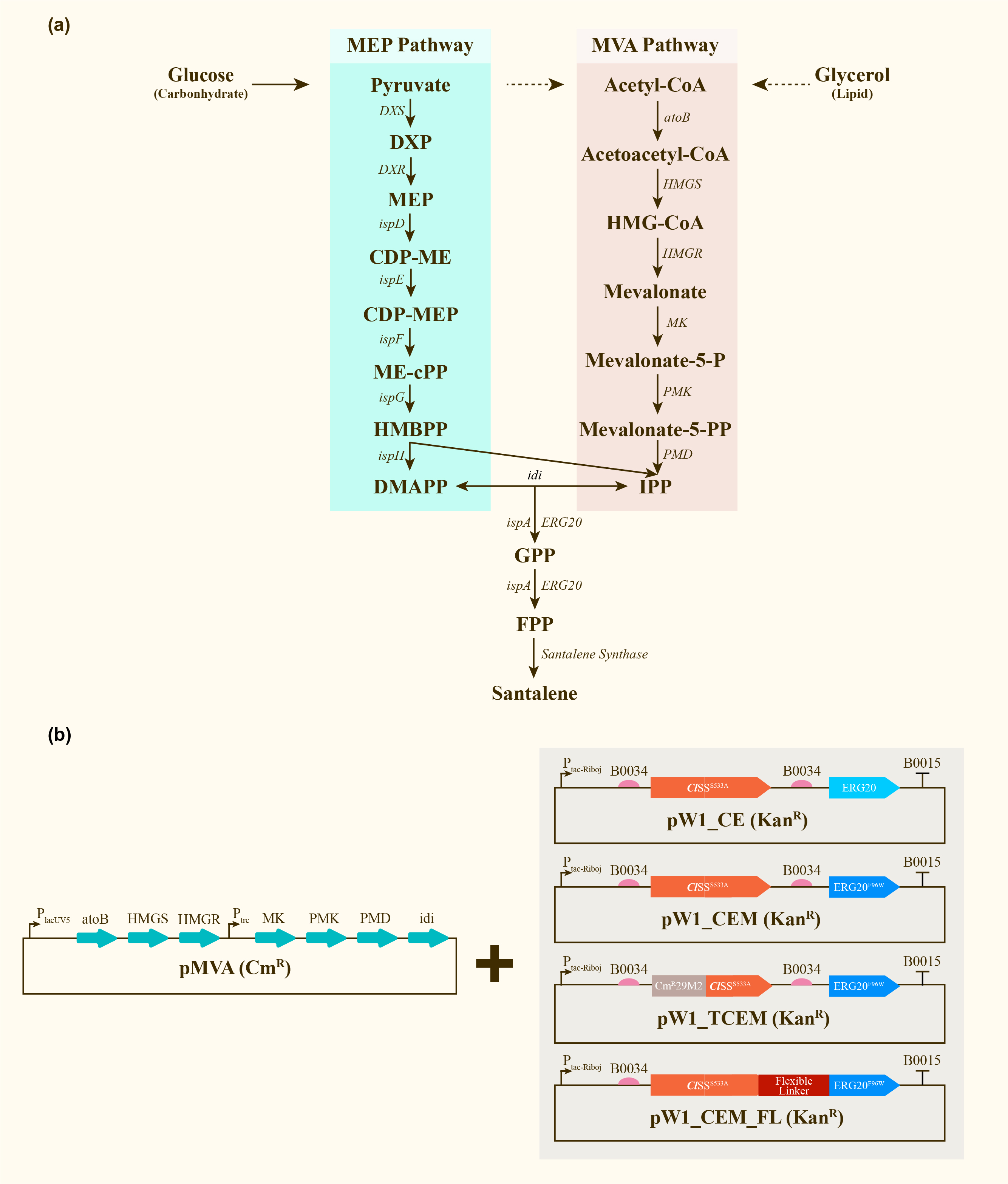Part:BBa_K4274031
ptac-RiboJ-B0034-ClSS_S533A-B0034-ERG20_F96W-B0015
ptac-RiboJ-B0034-ClSS_S533A-B0034-ERG20_F96W-B0015 was used to complete the pathway of IPP ⇄DMAPP → GPP → FPP → alpha-santalene. This part expresses the necessary enzymes (C. lansium santalene synthase and ERG20) participating in the formation of alpha-santalene. This composite part utilizes the promoter ptac-RiboJ (BBa_K3552015), which has an optimized productivity and is IPTG-inducible to initiate the later sequence. ptac-RiboJ is followed by the ribosome binding site (BBa_B0034), derived from the Elowitz repressilator. Then, we coded in the ClSS_S533A(BBa_K4274000), which mutated its 533th amino acid from serine to alanine, reaching the optimization of its effectiveness. C. lansium santalene synthase plays a crucial role to assist the transformation from FPP (farnesyl diphosphate) to alpha-santalene (the precursor of santalol). Then, after an identical ribosome binding site as before (BBa_B0034), we inserted the sequence for ERG20_F96W, which can catalyze the formation of FPP (farnesyl diphosphate). Compared with ERG20(BBa_K849001),ERG20_F96W’s 96th amino acid being mutated from phenylalanine to tryptophan turns out to significantly improve the yield of a-santalene. This part ends with the double terminator (BBa_B0015).
We have created a parts collection for all parts optimizing the production of alpha-santalene. This collection includes the series to optimize the activity of farnesyl pyrophosphate synthase, ERG20_F96W (Part: BBa_K4274002) and ptac-RiboJ-B0034-ClSS_S533A-B0034-ERG20-B0015 (Part: BBa_K4274030). A series conducting the secretion of ClSS and ERG20, consisting of CmR29M2-ClSS_S533A (Part: BBa_K4274001) and ptac-RiboJ-B0034-CmR29M2-ClSS_S533A -B0034-ERG20_F96W-B0015 (Part: BBa_K4274032). However, the comparative results revealed that this modification does not optimize the production of alpha-santalene. Finally, the series of parts expressing fusion protein ClSS_S533A-FL-ERG20_F96W (Part: BBa_K4274033), and BBa_K4274003.
We aim to assist future teams in their journey, providing a collection that optimizes the production of santalene.
Usage and Biology
ClSS_S533A refers to the mutated and optimized C. lansium santalene synthase, an enzyme that assists the transformation from FPP (farnesyl diphosphate) to alpha-santalene. ERG20_F96W is a mutated synthase that catalyzes the formation of FPP in the pathway that produces santalene. This composite part can express both optimized enzymes for the higher production of a-santalene.
Source
ClSS_S533A (Part: BBa_K4274000) is from Clausena lansium, and ERG20_F96W (Part: BBa_K849001) is from S. cerevisiae.
Characterization
After engineering, E. coli could utilize both MEP pathway and MVA pathway for the universal precursors isopentenyl diphosphate (IPP) and dimethylallyl diphosphate (DMAPP), then synthesize santalene with the help of FPP Synthase (FPPS) and santalene synthase (SS). Except heterologously expressed MVA pathway and ERG20 of Saccharomyces cerevisiae and santalene synthase of Clausena lansium (ClSS), several modifications upon ERG20 or ClSS by amino acid mutation, binding to a hydrophillic tag and the construction of fusion protein were tested for the higher yield of santalene. Therefore, with the help of the co-transformation of pMVA plasmid with various pW1 plasmids, including pW1_CE, pW1_CEM, pW1_TCEM and pW1_CEM_FL, different strains like CE, CEM, TCEM, CEM_FL were successfully constructed (Figure 1). The complete pathway we designed for producing santalene in E. coli is illustrated in Figure 1.

Afterwards, the various engineering of E.coli DH5α ∆TnaA mentioned above were used for santalene production. After rapid centrifugation, the supernatant of dodecane was spiked with with 0.475 g/L a-humulene as an internal standard, and then injected into GC/MS for verification of α-santalene production. It turned out that all samples from four strains appeared a significant peak at the retention time of 26-27 min, and various peak area of different samples exhibited santalene production with differing levels, indicating the general success of E. coli engineering. It can be concluded that the E. coli strain CEM (with pW1_CEM plasmid) produces the maximal level of α-santalene compared to other strains (73.93 mg/L). Furthermore, our study elucidates that the mutation of 96th amino acid into tryptophan could increase the yield of α-santalene by about 20%, substantiating the prominent performance of ERG20F96W in enhancing the supply of FPP and α-santalene production in E. coli (Figure 2).

Sequence and features
Sequence and Features
- 10COMPATIBLE WITH RFC[10]
- 12COMPATIBLE WITH RFC[12]
- 21COMPATIBLE WITH RFC[21]
- 23COMPATIBLE WITH RFC[23]
- 25INCOMPATIBLE WITH RFC[25]Illegal NgoMIV site found at 1541
- 1000COMPATIBLE WITH RFC[1000]
| None |
